Shar-Kali-Sharri
Shar-Kali-Sharri (𒀭𒊬𒂵𒉌 𒈗𒌷, DShar-ka-li-Sharri;[6] reigned c. 2217-2193 BC middle chronology, c. 2153-2129 BC short chronology) was a king of the Akkadian Empire.
| Shar-Kali-Sharri 𒀭𒊬𒂵𒉌 𒈗𒌷 | |
|---|---|
| |
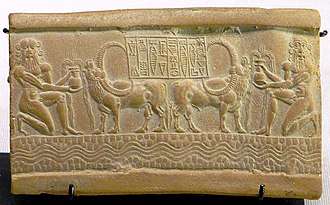 Impression of a cylinder seal of the time of Akkadian King Sharkalisharri, with central inscription: 𒀭𒊬𒂵𒉌 𒈗𒌷 𒁕𒈝 𒈗 𒀀𒂵𒉈𒆠 𒅁𒉌𒈗 𒁾𒊬 𒀵𒋢 | |
| King of the Akkadian Empire | |
| Reign | c. 2217 BC – 2193 BC |
| Predecessor | Naram-Sin |
| Successor | Igigi |
| Spouse | Tutasharlibish[5] |
| Dynasty | Dynasty of Akkad |
| Father | Naram-Sin of Akkad |
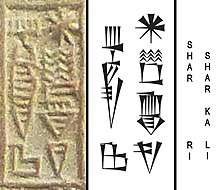
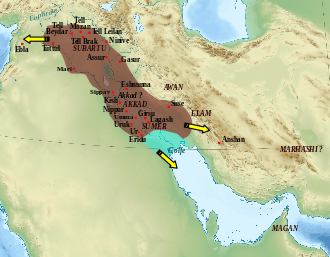
Rule
Succeeding his father Naram-Sin in c. 2217 BC, he came to the throne in an age of increasing troubles. The raids of the Gutian hill peoples of the Zagros mountains that began in his father's reign were becoming more and more frequent, and he was faced with a number of rebellions from vassal kings against the high taxes they were forced to pay to fund the defence against the Gutian threat.[7] Contemporary year-names for Shar-kali-sharri of Akkad indicate that in one unknown year of his reign, he captured Sharlag, king of Gutium, while in another year, "the yoke was imposed on Gutium".[8]
Year names of Shar-Kali-Sharri
Lists of year names can be found for many rulers from the time of the Akkadian Empire, including Shar-Kali-Sharri.[9] They shed light on the length of his reign and the main events:
- Year in which became king of Agade
- Year in which Szarkaliszarri having campaigned against Sumer, in the mountains...
- Year following the year Szarkaliszarri having campaigned against Sumer, in the mountains …
- Year in which Szarkaliszarri appointed Puzur-Esztar the shagina (general),[10] to build the temple of Enlil
- Year following the year Szarkaliszarri appointed Puzur-Esztar, the szagina, to build the temple of Enlil
- In the year in which Szarkaliszarri laid the foundations of the temple of Enlil in Nippur
- Year the foundations of the temple of Enlil (in Nippur) were laid
- Year following the year in which the foundations of the temple of Enlil in Nippur were laid
- Year the king Szarkaliszarri brought to the temple of Enlil …
- In the year in which Szarkaliszarri a vase of libation in gold (for the temple of Enlil and) cut down cedar timber for the temple of Enlil
- In the year in which Szarkaliszarri laid the foundations of the temples of the goddess Annunitum and of the god Aba in Babylon and took prisoner Szarlag(ab) the king of Gutium
- In the year in which Szarkaliszarri was victorious against Amurru
- In the year in which Szarkaliszarri was victorious over Amurru in the Djebel Biszri
- In the year in which Szarkaliszarri was victorious against Amurru
- In the year in which Szarkaliszarri brought the battle against Elam and Zahara in front of Akshak and … and was victorious
- In the year in which Szarkaliszarri was victorious against Elam and Zahara
- Year in which the yoke was imposed on Gutium
- In the year in which Szarkaliszarri …
- In the year in which Szarkaliszarri … Agade
- In the year in which Enlil … … Szarkaliszarri
- In the year in which Enlil … Szarkaliszarri …
- Year Szarkaliszarri the king of Agade...
- In the year in which Szarkaliszarri...
— Regnal year names of Shar-Kali-Sharri[11]
Submission of Sumerian kings
.jpg)
The submission of Sumerian rulers to Shar-Kali-Sharri, is recorded in the seal inscriptions of Sumerian rulers such as Lugal-ushumgal, governor (ensi) of Lagash ("Shirpula"), circa 2230-2210 BCE. Several inscriptions of Lugal-ushumgal are known, particularly seal impressions, which refer to him as governor of Lagash and at the time a vassal (𒀵, arad, "servant" or "slave") of Naram-Sin, as well as his successor Shar-kali-sharri.[13][14][15][16][17][18] One of these seals proclaims:
𒊬𒂵𒉌 𒈗𒌷 𒁕𒈝 𒈗 𒀀𒂵𒉈𒆠 𒈗𒃲𒁔 𒑐𒋼𒋛 𒉢𒁓𒆷𒆠 𒀵𒋢
Shar-kali-sharri da-num lugal a-ga-deki lugal-ušumgal ensi lagashki arad2-su"Shar-kali-sharri, the mighty king of Agade, Lugalushumgal, ensi of Lagash, is thy servant."
Loss of Lagash
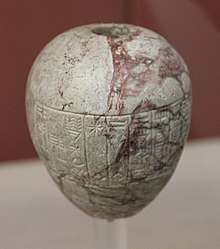
Although Lugal-ushumgal, Governor of Lagash, proclaimed himself as a vassal of Shar-Kali-Sharri, his successor Puzer-Mama took control of Lagash during Shar-kali-sharri's reign, when troubles with the Guti left the Sargonic king with only "a small rump state whose center lay at the confluence of the Diyala and Tigris river."[21] Puzer-Mama started the 2nd Dynasty of Lagash.
Out of the 24 years of his reign, names survive for some 18 of them, and indicate successful campaigns against the Gutians, Amorites, and Elamites, as well as temple construction in Nippur and Babylon.[22] Shar-Kali-Sharri reported defeating the Elamites at Akshak.[23][24]
Fall into anarchy
Sumer also suffered from a terrible drought during Shar-Kali-Sharri's reign in about c. 2200 BC, leading to the complete abandonment of some cities. This is complementary to Egyptian records, which suggest there was a drought around the same time during the reign of king Pepi II.[25] After Shar-Kali-Sharri's death in c. 2193 BC, Sumer fell into anarchy, with no king able to achieve dominance for long.[26] The king list states:
Legacy
The next recorded king of Akkad to rule for any reasonable amount of time was Dudu, who is said by the king list to have reigned for 21 years. However, by this time the Akkadian empire was no more, and Dudu most likely controlled no more than Akkad itself, meaning Shar-Kali-Sharri was the last Akkadian king to actually have an empire under his control.
In the 1870s, Assyriologists thought Shar-Kali-Sharri was identical with the Sargon of Agade of Assyrian legend, but this identification was recognized as mistaken in the 1910s.[27]
Inscriptions
.jpg) Tablet in Akkadian language recording domestic animals, Bismaya, reign of Shar-kali-sharri, c. 2100 BC, clay - Oriental Institute Museum, University of Chicago
Tablet in Akkadian language recording domestic animals, Bismaya, reign of Shar-kali-sharri, c. 2100 BC, clay - Oriental Institute Museum, University of Chicago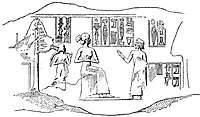 Seal of Shar-Kali-Sharri (previously attributed to Sargon), with seated deity.
Seal of Shar-Kali-Sharri (previously attributed to Sargon), with seated deity.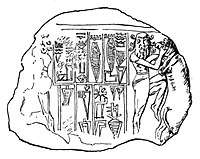 Seal of Shar-Kali-Sharri (previously attributed to Sargon), with Gilgamesh fighting a lion.
Seal of Shar-Kali-Sharri (previously attributed to Sargon), with Gilgamesh fighting a lion.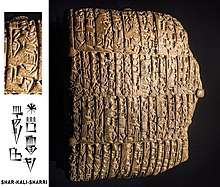 Cuneiform tablet from Nippur, in the name of Shar-Kali-Sharri (4th column), 2300 - 2100 BCE.
Cuneiform tablet from Nippur, in the name of Shar-Kali-Sharri (4th column), 2300 - 2100 BCE. Shar-Kali-Sharri seal
Shar-Kali-Sharri seal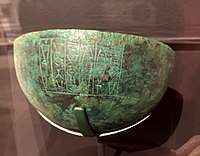 Bowl with inscription "To Shar-kali-sharri, king of Agade, Shaki-beli his servant.", Penn Museum.[28]
Bowl with inscription "To Shar-kali-sharri, king of Agade, Shaki-beli his servant.", Penn Museum.[28].jpg) Brick Stamp of Shar-Kali-Sharri (mirrored for readability). National Museum of Iraq.
Brick Stamp of Shar-Kali-Sharri (mirrored for readability). National Museum of Iraq.
See also
References
- Full transcription "CDLI-Archival View". cdli.ucla.edu.
- "Cylinder Seal of Ibni-Sharrum". Louvre Museum.
- "Site officiel du musée du Louvre". cartelfr.louvre.fr.
- Brown, Brian A.; Feldman, Marian H. (2013). Critical Approaches to Ancient Near Eastern Art. Walter de Gruyter. p. 187. ISBN 9781614510352.
- Elisabeth Meier Tetlow (2004). Women, Crime, and Punishment in Ancient Law and Society: The ancient Near East. Continuum International Publishing Group. ISBN 978-0-8264-1628-5. Retrieved 29 July 2011.
- written šar-ka3-li2-šar-ri2 𒊬𒂵𒉌𒊬𒌷 in later manuscripts of the Sumerian King List, but šar-ka3-li2 LUGAL-ri2 𒊬𒂵𒉌 𒈗𒌷 in royal inscriptions even though the LUGAL ("king") sign did not have the phonetic value of šar in Sumerian (Laurence Austine Waddell, The Makers of Civilization 1968, p. 529)
- John Haywood (2015-06-04). Chronicles of the Ancient World. Quercus Publishing Ltd. ISBN 978 1 84866 896 6.
- Year-names for Sharkalisharri
- "Year Names". cdli.ox.ac.uk.
- Hamblin, William J. (2006). Warfare in the Ancient Near East to 1600 BC: Holy Warriors at the Dawn of History. Routledge. p. 109. ISBN 978-1-134-52062-6.
- "Year Names of Sharkalisharri [CDLI Wiki]". cdli.ox.ac.uk.
- Radau, Hugo (2005). Early Babylonian History: Down to the End of the Fourth Dynasty of Ur. Wipf and Stock Publishers. pp. 6–7. ISBN 978-1-59752-381-3.
- "Sumerian Dictionary". oracc.iaas.upenn.edu.
- Radau, Hugo (2005). Early Babylonian History: Down to the End of the Fourth Dynasty of Ur. Wipf and Stock Publishers. pp. 6–7. ISBN 978-1-59752-381-3.
- "CDLI-Archival View RT 165". cdli.ucla.edu.
- Woolley, Leonard (1938). The Summerians. p. 83.
- The Art Of Ancient Mesopotamia ( Art Ebook). p. 53.
- Seal image M4 in: The Art Of Ancient Mesopotamia ( Art Ebook). p. 53.
- "CDLI-Archival View RTC 162". cdli.ucla.edu.
- BM 1883,0118.700
- Frayne, Douglas R. (1993). Sargonic and Gutian Periods p. 186, Toronto, Buffalo, London. University of Toronto Press Incorporated
- Year-names of Sharkalisharri
- Carter, Elizabeth; Stolper, Matthew W. (1984). Elam: Surveys of Political History and Archaeology. University of California Press. p. 15. ISBN 9780520099500.
- Potts, D. T. (2015). The Archaeology of Elam: Formation and Transformation of an Ancient Iranian State. Cambridge University Press. p. 188. ISBN 9781316586310.
- John Haywood (2015-06-04). Chronicles of the Ancient World. Quercus Publishing Ltd. ISBN 978 1 84866 896 6.
- John Haywood (2015-06-04). Chronicles of the Ancient World. Quercus Publishing Ltd. ISBN 978 1 84866 896 6.
- "But it is now evident that Sharganisharri was 'not confused with Shargani or Sargon' in the 'tradition' (p. 133), but only by the moderns who insisted on connecting the Sharganisharri of contemporary documents with the Sargon of the Legend" D. D. Luckenbill, Review of: The Civilization of Babylonia and Assyria by Morris Jastrow, Jr., The American Journal of Semitic Languages and Literatures Vol. 33, No. 3 (Apr., 1917), pp. 252-254.
- "CDLI-Archival View". cdli.ucla.edu.
| Regnal titles | ||
|---|---|---|
| Preceded by Naram-sin |
King of Akkad King of Kish, Uruk, Lagash, and Umma Overlord of Elam ca. 2254–2218 BC (Middle) |
Succeeded by Igigi |